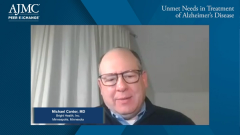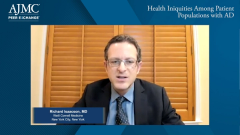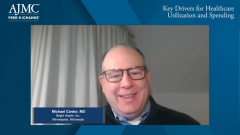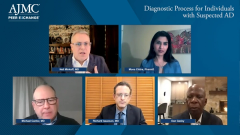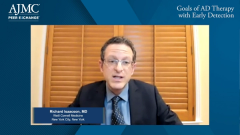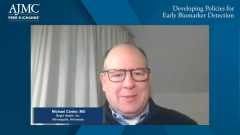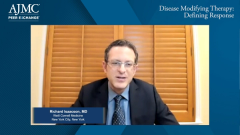
Diagnostic Process for Individuals With Suspected AD
A discussion on the typical journey of a patient with Alzheimer disease from initial presentation to proper diagnosis within the health care system.
Episodes in this series

Neil Minkoff, MD: One of the things I want to shift gears to here is that, before we get to the stage where people are accessing that level of benefit, we need to make sure they are properly diagnosed. We need to understand the diagnostic journey that patients are going through. I am going to start with Richard, if you could kick us off on that. If you could say, how are patients diagnosed with Alzheimer disease? What are some of the steps they go through for the differential diagnosis? Can you walk us through that from your point of view? I then want to get other people to weigh in from the other perspectives, whether it is coverage or the family.
Richard Isaacson, MD: As clinical neurologists, we follow the American Academy of Neurology guidelines, which honestly have not been updated in a while. As neurologists, we take detailed clinical histories. We want to understand when this person first started having the first symptom of memory loss. We want to understand whether this is a progressive short-term memory problem. Are there other symptoms that may clue us into a different dementia? Could this be a pseudo-dementia of depression? Could this be a metabolic or medical problem? About 5% to 7% of people who come in with memory conditions may have a vitamin B12 deficiency or a thyroid dysfunction, or they sometimes may have vitamin B12 deficiency and an early dementia.
These are complicated assessments, but a big part of our clinical diagnosis is made based on a detailed clinical history, and we spend at least 45 minutes talking to the patient and the family. It is almost impossible not to involve a family member because we need that objective opinion. We then go to the physical examination, and we do an exam to see whether this person has some weakness on one side or some other issues that may suggest a vascular problem, like a stroke. It may be that the person has had the early signs of vascular cognitive impairment, and they can sometimes have Alzheimer disease and vascular dementia.
These are imprecise techniques, but what we do is this: we then order laboratory tests to make sure that the thyroid, B vitamins, and a variety of other medical conditions may not be at play. We also do a depression screening, of course, and we order some tests. We then order a brain imaging study, either an MRI scan of the brain or a CT scan. I would say that most neurologists, even the majority of all physicians whether they are in primary care or psychiatry, prefer an MRI over a CT scan because you get so much more information.
I remember we [at Weill Cornell Medicine] wrote a paper back in 2006 or so, which is almost 15 years ago now. It was an article in a journal for radiologists about what the radiologist should know about mild cognitive impairment, and we talked about looking at the hippocampus, which is the memory center of the brain. We talked about looking for region-specific shrinkage or brain atrophy. Can we make a diagnosis of Alzheimer disease based on MRI? I would not that this is perfect, of course, but I have read a lot of MRIs, and I honestly think an MRI can be informative. If there is shrinkage where the memory center should be, you could even do volumetric analysis where the computer tells you if there is some shrinkage. You can now write on a requisition when a doctor is ordering it and ask, “Is this brain consistent with early Alzheimer disease?” A CT scan is OK, but it does not give us the same fidelity of information.
When the patient comes back, we also do cognitive assessments, of course. The cognitive assessments are tricky. There are no perfect cognitive tests out there. You can spend 15 minutes, 1 hour, 2 hours, or 5 hours. Reimbursements for some of these tests are challenging, but we try to take all the information, and digest the cognitive assessments, the MRI of the brain, and the clinical history to come to a diagnosis.
It is 2021, and we have made a ton of progress. We can do fancy tests, but a lot of the issues are that we can search for amyloid in the brain using a PET [positron emission tomography] scan, but these are expensive, several thousands of dollars, and they are not generally reimbursed by insurance. They are honestly not reimbursed almost at all. There is also spinal fluid testing: a lumbar puncture, a spinal tap looking for levels of amyloid and tau in the fluid, and that can help make a diagnosis. There are advanced tests and even serum tests. Blood tests are coming on the market. The first amyloid test came out recently, but it is not available across the entire United States. It is now available in Europe. Over the next year or 2, our landscape of diagnostic abilities and techniques are going to keep expanding, and the costs of these assessments are going to come down quite a bit.
In summary, we take a good clinical history. In an ideal world, we do all these fancy tests, but it is hard to get these tests. Sometimes, if we get the test, it is not going to change our management, so these are things that need to be thought of.
Neil Minkoff, MD: I am going to ask Mike, Dr. Cantor, if you could weigh in on that because there are a lot of challenges here in trying to apply not unlimited resources. They are good resources, but they are not unlimited resources being applied to a whole population to address a lot of those concerns. You have dealt with that on both sides of that equation.
Michael Cantor, MD: Exactly. One of the important things that Richard said is that it is complicated, even the diagnosis of Alzheimer disease. Mild cognitive impairment is an even better example; mild cognitive impairment comes in different flavors. It can be called amnestic, which means that it is a memory problem. It can be dysexecutive, which means it is in how your brain organizes complicated thoughts and starts and stops. It is not just about whether you remembered to go to the grocery store. It is, once you got to the grocery store, did you know how to shop, use a list, and make sure you paid properly? All of those executive functions can go, so that alone is a complicated discussion.
We try to explain that to patients and family members, what the difference is between Alzheimer disease and mild cognitive impairment, and then it’s memory cognitive impairment and the other one. With that discussion, let alone getting the test results, the point is also that you have to do the physical, and validate and verify all this information with a third party. We have a lot of people in the US [United States] who live alone, and finding that person who is able to validate what is going on accurately is difficult. As Dan mentioned earlier, there is such stigma from other people, that people are motivated not to talk about this. They do not want to face the challenges. It is like getting one of the worst diagnoses you can get in terms of your future with what this disease means for you, your loved ones, and your place in the community. All of that is so off-putting. You would think that having that simple discussion about how it is going and what is wrong would be pretty straightforward, but it is different than if you are talking about chest pain in the case of cardiac disease or if your knee hurts from arthritis, and you need to have it replaced. It is not just the stigma of the reality of living with this illness. It is also a disease that is not just the disease of the person; it is a disease of the whole family and community in some ways as well. That challenges and complicates the diagnosis.
With the tests that we have available, yes there are some tests, and more are coming, which is good news, and they will be cheaper and better. But they may not cover the differences between an amnestic cognitive impairment and the executive dysfunction or mixed Alzheimer disease and vascular dementia.
What matters to the people and to their families most, in my experience, is prognostics. Tell me, “Great, I have Alzheimer disease. What does that mean? How long do I have? What is it going to be like for me in terms of my memory and my functional status? Will I be able to feed myself 5 years from now, or will someone have to feed me? Will I not recognize my kids anymore?” For all those things, we do not have great answers.
We know, for example, that Alzheimer disease is a progressive illness, but there are things you can do to slow it down such as medicines, exercise, and environmental changes. If you have vascular dementia, there is a different set of treatments that can maintain it and stabilize it for longer, but doctors are not well trained. The primary care workforce is not well trained. There are few geriatricians who are in primary care who are available to do this stuff; there are few geriatric psychiatrists and neurologists. It is really hard to find someone. Dan’s experience with going to multiple physicians before getting the answer is unfortunately all too common.
It speaks to the need for better diagnostic testing, better treatment, and some honest conversations about how we are an aging society. It is not just the United States; it is the whole world. How are we going to work through this together? It clearly takes not just teams of clinicians and family members. It also takes communities, and it takes policy makers, and it takes the health plans to pay for the right things, and the clinicians and researchers to continue to make the progress they are making to make sure they are able to handle the tsunami, some have called it, of an aging society.
Dan Gasby: I want to say one quick thing. One of the reasons I got on and joined the American Brain Foundation was because I realized that we have never made the brain, for lack of a better term, sexy. All the major diseases, whether it be cancers, heart disease, or HIV, we have figured out how to market these things, but we have got to do it. You are starting to see it now because more and more TV shows, movies, and people are talking about it, but we have to double that commitment to making the brain sexy. Humanity starts between your ears and above your eyebrows. We have to start, whether it is ad councils or PSAs [public service announcements]. We have to take a long-term view as our aging population continues to grow to let the people before them understand that you are going to be involved with this. You are going to have to take care of your parents, brothers, sisters, and relatives, and we need to start to market that as something that is a necessary part of the aging process and life. We need to do a much better job.
Transcript edited for clarity.
Newsletter
Stay ahead of policy, cost, and value—subscribe to AJMC for expert insights at the intersection of clinical care and health economics.

